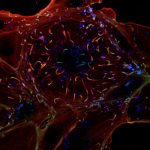About
Until now, the role of actin in cell migration has been extensively studied, but much less is known about the role of microtubules and Intermediate Filaments(IFs) (Dutour-Provenzano and Etienne-Manneville, 2021, 34033784; Etienne-Manneville, 2018, 30059630). Changes in IF composition are generally associated with tumor spreading, but the impact of IF composition on cell migratory behavior remains unknown. However several lines of evidence point to a role of IFs in cell migration (De Pascalis et al., 2018; Leduc and Etienne-Manneville, 2015, 25660489; Leduc and Etienne-Manneville, 2017, 28722513). The unique mechanical properties of IFs and their crosstalk with the other cytoskeletal networks hint at their participation in cell mechanics and mechanotransduction and therefore strongly suggest that IFs play an essential role in cell invasion in mechanically challenging microenvironments (van Bodegraven and Etienne-Manneville, 2021).
How are cytoskeletal elements reorganized to promote cell migration? Is the regulation of the cytoskeletal networks perturbed in glioblastoma cells?
- We have shown that the three main cytoskeletal networks, microfilaments, microtubules and intermediate filaments act in concert to promote astrocyte migration(Etienne-Manneville, Ann Rev Cell Dev Biol 2013).
- We have demonstrated the role of the tumor suppressor polarity proteins, such as APC and Dlg1, in the rearrangements of the microtubule network (Manneville, Jehanno et al., 2010).
- We have shown that APC directly interacts with intermediate filaments and forms a molecular bridge between microtubules and intermediate filaments to promote the parallel and polarized organization of the two cytoskeletal elements (Sakamoto et al. 2013).
Current work focuses on the role of post translational modifications in microtubule regulation and on the regulation of intermediate filament dynamics and functions during astrocyte and glioblastoma cell migration.
Role of Intermediate filaments in glioblastoma invasion.
Our hypothesis is that changes in IF expression influence intrinsic cell mechanical properties and mechanotransduction at focal adhesions to promote cell invasion in complex 3D microenvironment. We want to manipulate IF protein expression in GBM cells to determine the fundamental mechanisms by which IFs influence cell invasive behavior depending on the microenvironment.
What are the role and the dynamics of cell-cell interactions during cell polarization and collective directed migration? How loss of cellular interactions affects the migratory behavior of glioblastoma cells?
- We have shown that the adherens junction molecule N-Cadherin is downregulated in high grade gliomas. Low expression of N-cadherin increases astrocyte migration and alters astrocyte polarity and migration persistence, recapitulating several aspects of the abnormal migration of glioma cells in vitro (Camand et al. 2012). Microtubule staining of migrating glioblastoma cells. Cell polarization and orientation is strongly altered and cells do not maintain stable cell-cell interactions.
- We have revealed that the distribution of N-cadherin-dependent cell-cell contacts influence centrosome and nuclear positioning to define the orientation of the polarity axis (Dupin et al. 2009 & 2011). More recently we have uncovered how adherens junctions were maintained between adjacent migrating cells. We are now focusing on the regulation of N-cadherin dynamics during collective migration.
PhD project – Please apply to the PPU program if interested : https://www.pasteur.fr/en/education/ppu
Expected profile of the candidate
We are looking for highly motivated student with a strong interest in cell biology and cancer biology. Ideally, the candidate would have a strong scientific background in cell biology or in biophysics as well as previous lab experience in cell biology, live cell imaging, mechanobiology or image analysis.
The candidate will use recently generated IF-KO glioblastoma cell lines, and primary glioablastoma cells naturally expressing different IF protein levels to determine the contribution of IFs to glioblastoma cell invasion.
The study will include
- Live cell imaging of cell migration on 2D substrates of various rigidities to determine the role of IFs in mechanosensitive cell migration.
- A combination of biochemistry and traction force microscopy to determine the influence of IFs on signaling cascades regulating mechanosensitive gene expression and acto-myosin-mediated traction forces and to identify key molecular partners involved cytoskeletal crosstalk.
- The engineering of 3D hydrogels mimicking physiological extracellular matrices. Controlling the physical and biochemical properties of the cell microenvironment will enable the PhD student to decipher how IFs participate in cell responses to confinement, rigidity, and biochemical composition of the extracellular matrix to ensure cell migration efficiency.
- Working in collaboration with biophysics and bioinformatics teams to determine the role of IF in cytoplasmic and nuclear mechanical properties of the cell, analyse live cell imaging of fluorescent cytoplasmic and nuclear markers and map the spatiotemporal evolution of deformation, pressure and forces within the nucleus and the cytoplasm in WT and KO cells.
- Finally, determining how IF composition influence the cell ability to choose favorite paths of migration in vivo, using a zebrafish model.
This ambitious interdisciplinary project has a strong potential to generate new fundamental knowledge, technical breakthroughs and key clinically relevant results. In particular, it will provide fundamental bases for the use of IF expression as diagnostic markers and possibly as therapeutic targets to influence or prevent GBM cell invasion.





